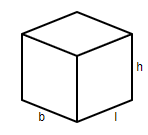
A cuboid has a total surface area of $50{{m}^{2}}$and lateral surface area is $30{{m}^{2}}$ . Find the area of its base.
Answer
564.9k+ views
Hint: We have a cuboid whose total surface area is $50{{m}^{2}}$ and the lateral surface area is $30{{m}^{2}}$. We need to find the area of its base. Let us assume that the length, breadth, and height of the cuboid are l, b, and h respectively. As we know that the total surface area of cuboid is given by: $TSA=2\left( lb+bh+lh \right)$ and lateral surface area of cuboid is given by: $LSA=2\left( bh+lh \right)$ . Now, put the values of total surface area and lateral surface area in these formulas and get the value of $\left( l\times b \right)$ . The value of $\left( l\times b \right)$ is the area of its base.
Complete step by step answer:
We have a cuboid as shown in the figure:

We have:
Total surface area of cuboid:$TSA=50{{m}^{2}}$
Lateral surface area of cuboid: $LSA=30{{m}^{2}}$
As we know that:
$TSA=2\left( lb+bh+lh \right)$
$LSA=2\left( bh+lh \right)$
So, by putting the value of TSA and LSA, we get:
$\begin{align}
& \Rightarrow 2\left( lb+bh+lh \right)=50{{m}^{2}}......(1) \\
& \Rightarrow 2\left( bh+lh \right)=30{{m}^{2}}......(2) \\
\end{align}$
We can write equation (1) as:
$\Rightarrow 2\left( lb \right)+2\left( bh+lh \right)=50{{m}^{2}}......(3)$
Now, put the value of $2\left( bh+lh \right)$ from equation (2) in equation (3), we get:
$\begin{align}
& \Rightarrow 2\left( lb \right)+30{{m}^{2}}=50{{m}^{2}} \\
& \Rightarrow 2\left( lb \right)=20{{m}^{2}} \\
& \Rightarrow \left( l\times b \right)=10{{m}^{2}} \\
\end{align}$
Hence, the area of the base is $10{{m}^{2}}$.
Note: The lateral surface of an object covers all of the sides of the object, excluding its base and top (when they exist). The lateral surface area is the area of the lateral surface. Whereas, the total surface area of an object is the area of all the faces of an object, which means that the total surface area includes the lateral surface area as well as the area of top and base of the object.
Complete step by step answer:
We have a cuboid as shown in the figure:

We have:
Total surface area of cuboid:$TSA=50{{m}^{2}}$
Lateral surface area of cuboid: $LSA=30{{m}^{2}}$
As we know that:
$TSA=2\left( lb+bh+lh \right)$
$LSA=2\left( bh+lh \right)$
So, by putting the value of TSA and LSA, we get:
$\begin{align}
& \Rightarrow 2\left( lb+bh+lh \right)=50{{m}^{2}}......(1) \\
& \Rightarrow 2\left( bh+lh \right)=30{{m}^{2}}......(2) \\
\end{align}$
We can write equation (1) as:
$\Rightarrow 2\left( lb \right)+2\left( bh+lh \right)=50{{m}^{2}}......(3)$
Now, put the value of $2\left( bh+lh \right)$ from equation (2) in equation (3), we get:
$\begin{align}
& \Rightarrow 2\left( lb \right)+30{{m}^{2}}=50{{m}^{2}} \\
& \Rightarrow 2\left( lb \right)=20{{m}^{2}} \\
& \Rightarrow \left( l\times b \right)=10{{m}^{2}} \\
\end{align}$
Hence, the area of the base is $10{{m}^{2}}$.
Note: The lateral surface of an object covers all of the sides of the object, excluding its base and top (when they exist). The lateral surface area is the area of the lateral surface. Whereas, the total surface area of an object is the area of all the faces of an object, which means that the total surface area includes the lateral surface area as well as the area of top and base of the object.
Recently Updated Pages
Two men on either side of the cliff 90m height observe class 10 maths CBSE

What happens to glucose which enters nephron along class 10 biology CBSE

Cutting of the Chinese melon means A The business and class 10 social science CBSE

Write a dialogue with at least ten utterances between class 10 english CBSE

Show an aquatic food chain using the following organisms class 10 biology CBSE

A circle is inscribed in an equilateral triangle and class 10 maths CBSE

Trending doubts
Why is there a time difference of about 5 hours between class 10 social science CBSE

Write a letter to the principal requesting him to grant class 10 english CBSE

What is the median of the first 10 natural numbers class 10 maths CBSE

The Equation xxx + 2 is Satisfied when x is Equal to Class 10 Maths

Which of the following does not have a fundamental class 10 physics CBSE

State and prove converse of BPT Basic Proportionality class 10 maths CBSE




